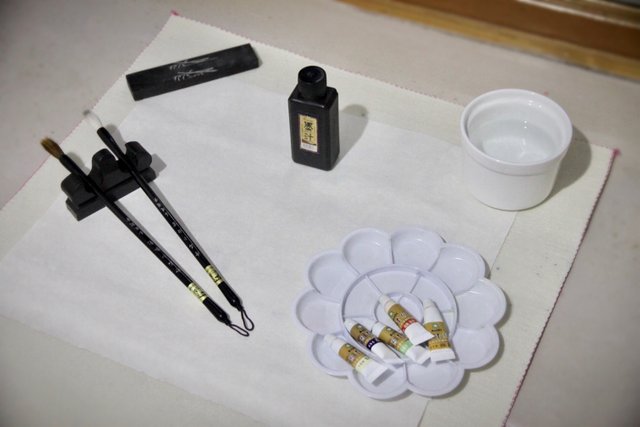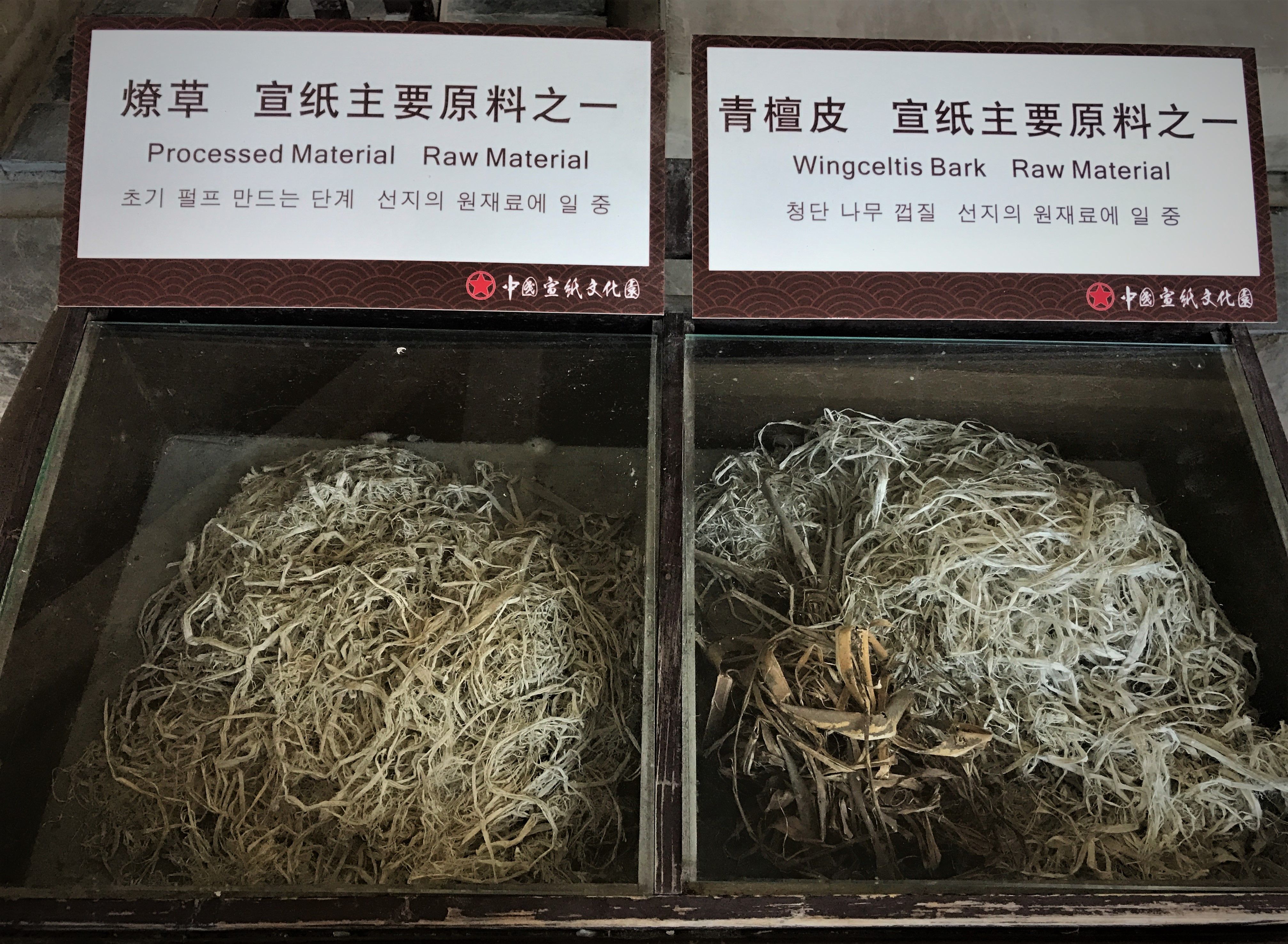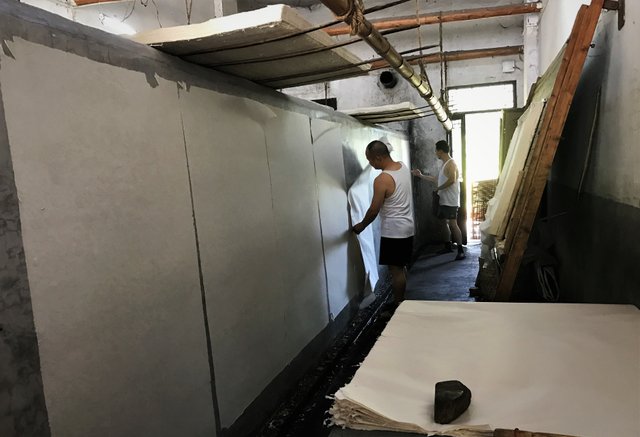#87 Paint with Donica - 4 Treasures of Chinese Painting + Recreating Film Characters 来画国产动画角色 + 文房四宝小知识 | 齐白石杯 月旦评
~ About the Animated Film ~
Inspired by @angelina6688's drawing contest themed "Animated Film Characters", I painted a scene from a Chinese animated film: "Where's Mama?" This narrated short film was produced in Shanghai in 1960. That is a period when plenty of classical animated movies were created in China. I would love to paint more of them in the coming future.
I just love these old traditional movies created from Chinese ink and wash paintings. To me, they were so beautifully done in a time without much fancy technology, and they are timeless with native Chinese aesthetics. It's the director's attempt to break away from Western style animation, influenced by the style of the Chinese painting master, Qi Baishi. I am by no means a master in Chinese painting, but I'm attempting to recreate the characters from the film: the little tadpoles and their frog mama.
"Where's Mama?" is a story about a group of little tadpoles in search of their mother. After some adventures and misadventures of encountering water creatures like shrimp, gold fish, crab, turtle, catfish... they finally find their mother frog.
~ 关于《小蝌蚪找妈妈》~
感谢@angelina6688举办"齐白石杯"绘画比赛,让我重拾多年没碰的毛笔。这期主题是“动漫角色”,虽然我也看过些盛行的日本动漫,年少无知时还和同学成立了动漫俱乐部,玩过cosplay,但看到题目时,我最先想到的却是中国60年代众多的国产动画。
其中1960年的《小蝌蚪找妈妈》是中国乃至世界第一部水墨动画片,斩获多项国际大奖,堪称动画中的精品。什么?我这是暴露年龄了吗?好吧,你也可以说因为小蝌蚪们只是一堆墨点,所以是最简单易画的角色。😄 但是,上海美术电影制片厂的大师们却利用这些墨点的游动,在短短15分钟内,出神入化地将中国山水画的韵味和栩栩如生的角色描摹相结合,带给我们充满意趣的光影艺术享受。在那个电影技术不发达的年代,这种突破西方动画制作手法,表现中国古典美学的尝试真是难能可贵啊!(这句式叫我想起小学作文结尾常用的感叹......)
当年的动画制作人觉得齐白石的画印在脸盆上看上去很逼真,就想尝试着把它做成动画。于是便有了水墨动画《小蝌蚪找妈妈》,它的原型出自白石老人的名作《蛙声十里出山泉》。当然,我的艺术修养和绘画技艺不及白石老人的万分之一,但还是借此机会拿起画笔,享受下挥洒的乐趣吧。另外,因为从小对满大街的笔墨纸砚、字画装裱比较熟悉,所以我在贴出绘画步骤时,也用中英文对文房四宝等国画的基础知识做个简要介绍,正好响应大伟哥@rivalhw牵头的@cn-reader传播中华文化的号召。

What I Use: 👆
Oriental Brushes, Raw Rice Paper, Chinese Ink, Chinese Pigments, Palette/Saucers, Brush Washer(Water Container)
The rest 3 are optional: Paperweights, Mat, Brush Holder
So in the following content I'm going to include also the introduction of "Four Treasures of the Chinese Study", namely brushes, ink, paper and ink stone. These are the basic necessities required in a scholar's study in ancient China, to create a calligraphy or painting work.
~ About Brushes ~
Here I have 2 round brushes with a sharp tip (I'd like to use more but I only found these 2 varieties in a shop):
The one on the left is supposed to be made from stiff hair such as wolf or ox... The hair retains a bounce when wet and regains its sharp tip when you decrease the pressure on it, so you can vary the width of a brushstroke when writing or painting with ink.
The one on the right is supposed to be made from soft hair such as goat or rabbit... The hair becomes floppy and flexible when wet, so it's generally used to paint great surfaces and for gradations of colours.
There is another kind of brush with mixed hairs. Its external crown is made of flexible goat/rabbit hairs, with an interior end of hard wolf/ox hairs. So it combines the quality of the two above-mentioned brushes.
材料:毛笔、生宣、墨、国画颜料、调色盘/碟、笔洗+清水、镇纸、毛毡、笔山(后三项可选)
~ 关于毛笔 ~
左边深色毛的是小狼毫,正品的话顾名思义是由狼毫制成,毛质较硬,控制笔画粗细相对容易。
右边浅色毛的是小白云,正品的话一般是兔毛、羊毛之类的软毛制成,蘸水变软,所以多用来大面积晕染颜色。
还有种介于以上两者中间的叫兼豪,外面一圈软毛,内侧是硬毛,绘画效果自然也是介于狼毫和羊毫笔之间。
Step 1: Use the stiff-hair brush to outline the shape of a lotus.
第一步:用稍硬的狼毫笔大致勾出荷花的轮廓。(其实我那两只烂笔用起来并没多大区别)
~ Freehand Style VS Gongbi Style ~
Here I apply the freehand style, also known as ink and wash painting in China. Another type of Chinese painting is called Gongbi, literally "meticulous", different from the freehand style that focuses on the general conception and rhythm, Gongbi usually depicts figurative or narrative subjects in highly detailed brushstrokes.
In ancient China, Gongbi is often practiced by artists who works for the royal court or in independent workshops. While the ink and wash painting was one of the "Four Arts" of the Chinese scholars and officials.
~ 写意 VS 工笔 ~
这里我用的是类似《小蝌蚪找妈妈》水墨动画中的写意画法,不求形同,只求神似😁。还有一种国画种类就是众所周知的工笔,在古代一般是宫廷画师或独立画匠赖以生存的饭碗。而水墨画则主要是古代的学者官员们“琴棋书画”这些雅兴中的一种,通俗点说就是吃饱了撑着没事干时用来画着玩玩的~ 还请原谅我看破红尘的粗鲁。
Step 2: Use the soft-hair brush to paint the lotus leaf, water and the base of plants.
第二步:用稍软的笔染出荷叶、池水和水草。
~ About the Paper ~
You can see that the raw rice paper is absorptive, which is good for ink or pigments to make ranges and to show textures. This kind of Shengxuan paper is widely used for Chinese calligraphy and ink paintings. Actually I feel the paper I used is like a semi-raw one, as it's not that absorptive and gets dry quickly.
Another type is called Shuxuan or Fanxuan paper, literally means alum paper. It is the raw absorbing paper coating with an alum solution. So it is not absorbing the ink or pigments, which is used for the precise layout of Chinese paintings, like the Gongbi type I talked about earlier.
A particular Chinese silk called Juan is also used by painters. This glossy fabric boasts a lustre for expressing textures in some Gongbi paintings, but silk deteriorates much faster than the 2 kinds of rice paper.
Rice paper is known as "long-lasting paper of a thousand years", with a history of over 1500 years. Most of the paintings and calligraphy works from ancient China done on rice paper are still in a great condition. It is because the paper is made of straw from the rice plant(thus rice paper) and unique Qingtan tree(Wingceltis) barks (pictured below), which contribute to the resilient texture. I once visited a paper-making factory, and I was amazed by the process of creating this wonderful medium for Chinese painting and calligraphy.


photos by @itchyfeetdonica in the Rice Paper Cutural Museum and Workshop in Anhui Province, China
~ 关于宣纸和熟绢 ~
我用的是(半)生宣纸,墨汁和颜料较容易晕染开来,所以这种纸一般用在写意画和大幅书法上。而熟宣或熟绢则是生宣纸或生绢经过一定比例的胶矾水刷制成的。因为其不渗墨色的性能而多被用来画工笔。熟宣纸有薄有厚,胶矾水含量有浓有淡,以蝉翼笺最薄,冰雪宣最厚,还有书画笺、云母笺、清水书画宣等。通常薄笺适合画淡彩,厚宣适合画重彩。熟绢比熟宣纸有光泽,工笔画面效果较好,但不容易经久保存,所谓“千年陈丝不如草”,“纸寿千年绢寿八百”。
我曾去宣纸厂参观过造纸过程,宣纸主要以青檀树皮和沙田稻草为原料(见上图),檀皮决定纸的韧性和拉力,稻草决定纸的洁白度与柔软度。当地独特的水质和青檀皮使制造出来的宣纸韧性强、耐老化、少虫蛀,寿命长,被称为“千年寿纸”,造纸工艺迄今已有1500多年历史。薄、轻、软、韧、细、白的纸张有助于书画创作时达到“墨韵万变”的效果。 根据檀皮与稻草的不同配比,宣纸又可细分为棉料、净皮、特种净皮三大类,还可按大小规格、纸面纹理分类,但今天就不扯那么多了,留待下次吧。
Step 3,4,5,6...: Draw the frog, the tadpoles and the grass with the hard-hair brush. Color the lotus flower and the frog. Use the soft-hair brush to dot the soil and to add more layers to the water and plants.
第三、四、五、六......步:画完剩下的青蛙妈妈和蝌蚪宝宝,给荷花、大片水草染色,点出更多前景的淤泥和细草。
~ About the Pigments & Ink Stone ~
As I was so involved in painting, I forgot to take pictures for each step. I only realized it when I almost finished the whole thing, haha... Sorry for that. When I was painting, I found the pigments contain more particles than the genuine Chinese paint. It's more like the Western gouache paint, so I decided to draw the frog in a more "gouache" way. That's why you don't see the Chinese-painting style frog here which resembles a dark fluffy mud fish to me.
Chinese pigments contain more glue than Western gouache paint and watercolours, making the pigment bind better to rice paper and silk. Outside of some basic traditional pigments made from natural plants and minerals without glue, other colours are made from synthetic chemicals. For example, the 5 tubes I used are synthetic versions that already contain glue.
Traditionally, to get the ink for painting, Chinese painters use a solid ink stick to rub on a stone with water. When they control the time of rubbing, various densities of ink could be obtained. The ink stone can come with many forms and sizes, which is considered as art itself. Today, most of us just buy ink in small bottles or cans, like what you see in my photo.
~ 关于颜料 & 墨砚 ~
这里因为我画得太尽兴,一时忘了拍照,等到几乎画完才想起来没有一步步拍,罪过😆,都怪我这人生太随性~。尽情挥洒泼墨的时候,我一度发现这劣质颜料颗粒很大,更像是画水粉的,再说山水画里的青蛙通常是个毛绒绒的黑团,我觉得跟泥鳅更神似,所以我画青蛙妈妈时索性放弃了写意画法,反正主角是蝌蚪宝宝们。哈哈哈,我是不是太不拘小节,画随心动了?😏
国画颜料主要是矿物和植物提取物制作的,除了十几种自然基础色外,其他颜色多为化学合成物。和水彩、水粉画颜料一样都可用水稀释,但国画颜料的水性胶含量大过水彩颜料, 而颗粒较水粉画颜料更细。国画颜料相比油画更柔和,不像油画颜料那么容易覆盖,适合小面积的涂染。 油画颜料则是矿物和化学合成物制作的,用的是松节油等植物提取油,不含水性胶。
关于墨汁,传统的做法自然是用墨条在砚台上磨,还记得古装戏里温柔磨墨的妃子或书童吗?还好我没生在古代...... 这事儿还真考验耐心~ 不禁暗暗感激发明瓶装墨汁的人。根据磨墨的时间和力道不同,墨自会产生深浅浓淡的差别,再加上水的调和作用,墨分五色,变幻无穷。砚台本身也是造型多样、材质各异,很多都是具有收藏价值的艺术珍品。古代文人墨客对砚十分重视,不仅常相随,死后还用来殉葬。米芾就对一方山形砚台爱不释手,苏东坡也爱称砚台为“石君”、“石友”。
~ About the 4 Basic Techniques ~
So I've talked about the "Four Treasures of the Chinese Study" - brushes, ink, paper and ink stone, plus the two styles of Chinese painting and differences between Chinese pigments and the western ones. Now I'd like to move on to the 4 basic brush techniques of Chinese painting: gou (outlining/contouring), cun + ca (wrinkling/texturing + rubbing), dian (dotting) and ran (coloring/dyeing). Gou is to draw lines of the basic shapes; Cun + ca is for the textures and shades of rocks, mountains, trees and plants...; Dian is to dot the moss, grass and spots on rocks; Ran is to dye the landscape to make layers. There are still so many more tips and techniques but I won't ramble on today in this post - it's already long enough. I'm more than happy if you have read along till here.
~ 关于基本技法 ~
刚才讲到笔墨纸砚这文房四宝和颜料(敲黑板......),现在继续简要聊聊中国画用笔的技法,虽然我这次画的并不是纯正的国画,只是对动画角色的再创造而已。根据古典法则,四个基本技法是“勾、皴、点、染”。“勾法”指用各异的线条表现不同形态和质感;“皴法”用来表现山石树木的质地、脉络、凹凸、阴阳、向背;“点法”是说点出山石上的苔藓、斑点等;“染法”指用淡墨或色彩将景物染出立体感。至于具体的步骤,限于篇幅就不再介绍,而且我这种疏于练习、随意放飞自我的业余水平就不瞎班门弄斧、贻害众生了。况且国画的气韵也不是一点技法就可以表现出来的,需要长期的观察、体验、修养和练习。感兴趣的童鞋可以跟Steemit上的@helene, @dancingapple等国画好手潜心学习~ 🙂
So that's it for today's content about Chinese painting. Hope you like it and my painting! Tell me what you think in the comments! Until next time. =)
欢迎留言分享你的想法,下次见喽~
All content by @itchyfeetdonica.
照片文字均为原创
Thank you for reading. Check out my recent posts, and follow me for more! =)
我被遣返科索沃 So I Was Sent Back to Kosovo
A Photo Journey: Exploring Aryapala Meditation Temple 蒙古禅修图片之旅
Batik Stories (1) - My First Batik Work in Indonesia 蜡染系列(一)我的蜡染处女作
Some SMILE Portraits in My Travels 旅途中的微笑
Stories of Shadows (2@Europe + 2@South America) 光影交错的瞬间

Here are some screenshots from my Instagram. Follow @ItchyfeetDonica for more shots around the globe !

!steemitworldmap 30.629358 lat 118.425742 long Rice Paper Cultural Museum d3scr
what kinda paper are you using? looks very much different!
Beautiful work btw :)
Thanks! :) I mentioned in “About the Paper” part: I used rice paper which is a common medium for Chinese painting. It’s absorbing the ink/pigments.
How did you see my post btw? I haven’t explored the art circle on Steemit yet - been busy with travel and photography. =)
oh that amazing! I haven't seen anything like it before, looks too brittle.
I was going through new posts on steemit looking for nice presentations and baaam! found you :)
Beautiful work btw :)
月旦评评语:作者将家喻户晓的“小蝌蚪找妈妈”这个中国故事,用水墨画的方式表现出来。彰显了独特的艺术风格,憨态可掬的小蝌蚪也是中国传统动画代表角色之一。整幅画卷清新又俏皮。
噢~ 谢谢评委的独特点评 😊
I didn't even know that there were old Chinese movies like that, that's super cool! If like to see one. The frog is so cute!! I feel like there's a cartoon story behind it and I feel like I know the frog already. Lol that's probably weird, I don't know how to explain it. But it means you're a great artist because you made the character come alive.
Super cool to see this kind of artwork. I love this!!!
Thanks Rebecca(not Eric right?)! Great to hear how you feel about the frog. I'm so flattered, haha...
小多 + @helene + 小魔仙 = 斯丁密国画三圣!
不敢不敢 我超业余的水平 多年没有碰毛笔了
Congratulations, Your Post Has Been Added To The Steemit Worldmap!
Author link: http://steemitworldmap.com?author=itchyfeetdonica
Post link: http://steemitworldmap.com?post=87-paint-with-donica-recreating-chinese-cartoon-characters-or
Want to have your post on the map too?
你好!cn区点赞机器人 @cnbuddy 谢谢你对cn区的贡献。假如我的留言打扰到你,请回复“取消”。
Congratulations! This post has been upvoted from the communal account, @minnowsupport, by ItchyfeetDonica from the Minnow Support Project. It's a witness project run by aggroed, ausbitbank, teamsteem, theprophet0, someguy123, neoxian, followbtcnews, and netuoso. The goal is to help Steemit grow by supporting Minnows. Please find us at the Peace, Abundance, and Liberty Network (PALnet) Discord Channel. It's a completely public and open space to all members of the Steemit community who voluntarily choose to be there.
If you would like to delegate to the Minnow Support Project you can do so by clicking on the following links: 50SP, 100SP, 250SP, 500SP, 1000SP, 5000SP.
Be sure to leave at least 50SP undelegated on your account.
厉害啊,原来你也会画画,还是国画
我真的是很业余的 哈哈
我都未聽過《小蝌蚪找妈妈》,原來你比我老多了!
by the way, 相比起圖畫,我對你的cosplay比較有興趣🤣
可惜我们60年代人不像你们这些年轻人 没有手机相机那么方便拍下每个cosplay的瞬间啊
哇呜呜!!!!!你简直太棒了!!!我要退你上热门!!!哈哈哈
谢谢美女画家夸奖 热门在哪里 在哪里 我去看看有没有我在上面?😄